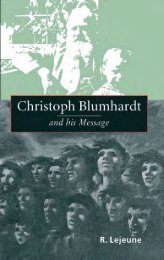AN INTRODUCTION TO KANT'S AESTHETICS
AN INTRODUCTION TO KANT'S AESTHETICS
AN INTRODUCTION TO KANT'S AESTHETICS
Create successful ePaper yourself
Turn your PDF publications into a flip-book with our unique Google optimized e-Paper software.
136 TWO CHALLENGES<br />
one has to wonder whether one might not equally well say that all poetry is<br />
written down already somewhere in a Platonic realm of poetry.<br />
There is, then, no unique way to solve problems in mathematics that could<br />
count as “the natural path of enquiry and reflection in accordance with rules.”<br />
Similarly, the expression “in accordance with rules” (nach Regeln) is problematic.<br />
It is rather vague and can be misleading. Rules do not prescribe how they have<br />
to be used. (The German word “nach” suggests an even stronger connection<br />
between reflection and rules than does the English expression “in accordance<br />
with.”) There is always much freedom in how and where to make use of them,<br />
when and what to take, let, and apply to what. Rules even change. After all, there<br />
is a history of mathematics. The old rules usually do not turn out to be false.<br />
They simply apply to an older part of mathematics that is not being considered<br />
any more, that has been modified, or that has been integrated into another area<br />
of mathematics.<br />
It is for these reasons that Newton cannot, contrary to what Kant wrote, make<br />
“entirely intuitive” all “the steps that he had to take” (see quote above), simply<br />
because he did not really have to take them and because other steps were possible,<br />
too. Just think of Leibniz’s infinitesimal calculus as an alternative to<br />
Newton’s. The steps are “intuitive” in the sense that we can reproduce them, that<br />
they do not violate other mathematical rules, that they make sense, and that they<br />
are part of a theory that works as far as we can see at the time and within a<br />
certain framework. The steps are intuitive in this sense, but not in an absolute<br />
sense, as if no other steps were possible. Moreover, a new theory often makes us<br />
look further and enlarge that framework, as was the case with relativity theory,<br />
for instance. The concept of what is “entirely intuitive” changes if we adopt a<br />
Kuhnian or Wittgensteinian perspective, making us more aware of historical,<br />
social, and cultural aspects.<br />
Of course, in many respects mathematics is not like poetry. There are strict<br />
rules in mathematics that should never be violated, such as the rule of non-contradiction.<br />
So there is more freedom in poetry. And mathematics is more abstract<br />
than poetry, because you can sometimes change a line here and there and still<br />
say that it is the same proof, which is hardly so in poetry. There we would tend<br />
to say that changing a line is making another poem. But nevertheless, there are<br />
creative elements in mathematics that Kant might have underestimated. We will<br />
come back to this.<br />
From the mid-1780s on we find several passages that relate rules to learnability<br />
and taste and at the same time separate all these aspects from genius and the<br />
arts:<br />
If I derive rules from other rules that are already known, this is a case of talent but<br />
not of genius. (Anthropology Lecture Notes Mrongovius, 1784/85, XXV 1310)



